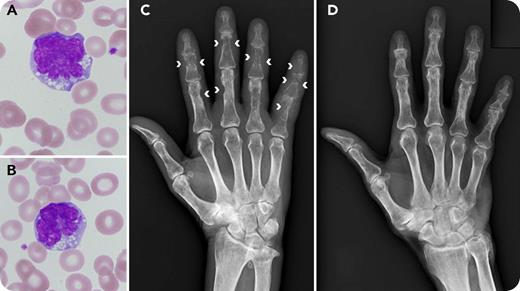A 68-year-old man with a history of adult T-cell leukemia/lymphoma (ATLL) presented to our outpatient clinic complaining of painful hand swelling of 3 weeks’ duration. Neither enlarged lymph nodes nor skin lesions were observed. The total leukocyte count was normal (5.2 × 109/L) with 3% atypical lymphocytes. The atypical lymphocytes were medium-sized cells with nuclear abnormalities, such as lobulation and notching (panels A-B; original magnification ×1000, Wright-Giemsa stain), and were positive for CD3, CD4, and CD25. The soluble IL-2 receptor level was 17 400 U/mL (normal range, 145-519 U/mL). Radiographs showed multiple subperiosteal bone resorption in the phalanges (panel C; arrowheads).
Subperiosteal bone resorption of the phalanges typically occurs in hyperparathyroidism. Osteoclastic resorption on the periosteal surface gradually proceeds toward the bone center. In our case, serum calcium and intact parathyroid hormone were normal, whereas serum parathyroid hormone–related protein was elevated (1.7 pmol/L; normal range, <1.1 pmol/L). The patient was diagnosed as having relapsed ATLL and received chemotherapy containing the anti-CCR4 antibody mogamulizumab. As a result, rapid relief of the symptoms was obtained. Five months later, the bone lesions also improved (panel D), showing the association of the bone lesions with ATLL disease status. This is the first report of mogamulizumab-sensitive and reversible subperiosteal bone resorption of the phalanges in ATLL.
A 68-year-old man with a history of adult T-cell leukemia/lymphoma (ATLL) presented to our outpatient clinic complaining of painful hand swelling of 3 weeks’ duration. Neither enlarged lymph nodes nor skin lesions were observed. The total leukocyte count was normal (5.2 × 109/L) with 3% atypical lymphocytes. The atypical lymphocytes were medium-sized cells with nuclear abnormalities, such as lobulation and notching (panels A-B; original magnification ×1000, Wright-Giemsa stain), and were positive for CD3, CD4, and CD25. The soluble IL-2 receptor level was 17 400 U/mL (normal range, 145-519 U/mL). Radiographs showed multiple subperiosteal bone resorption in the phalanges (panel C; arrowheads).
Subperiosteal bone resorption of the phalanges typically occurs in hyperparathyroidism. Osteoclastic resorption on the periosteal surface gradually proceeds toward the bone center. In our case, serum calcium and intact parathyroid hormone were normal, whereas serum parathyroid hormone–related protein was elevated (1.7 pmol/L; normal range, <1.1 pmol/L). The patient was diagnosed as having relapsed ATLL and received chemotherapy containing the anti-CCR4 antibody mogamulizumab. As a result, rapid relief of the symptoms was obtained. Five months later, the bone lesions also improved (panel D), showing the association of the bone lesions with ATLL disease status. This is the first report of mogamulizumab-sensitive and reversible subperiosteal bone resorption of the phalanges in ATLL.
For additional images, visit the ASH Image Bank, a reference and teaching tool that is continually updated with new atlas and case study images. For more information, visit http://imagebank.hematology.org.


This feature is available to Subscribers Only
Sign In or Create an Account Close Modal